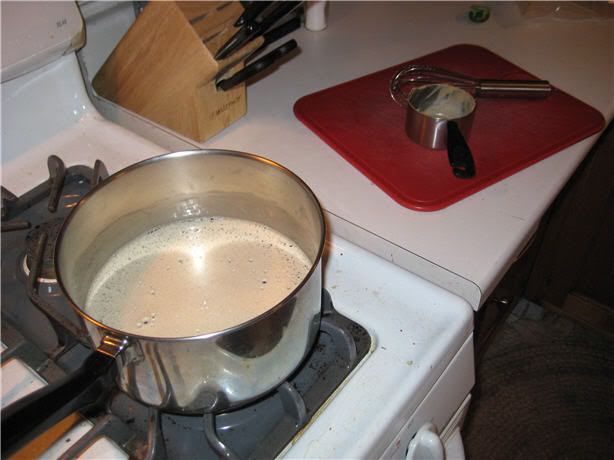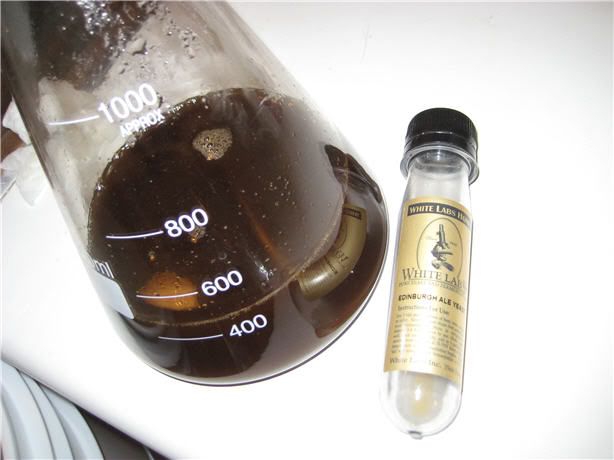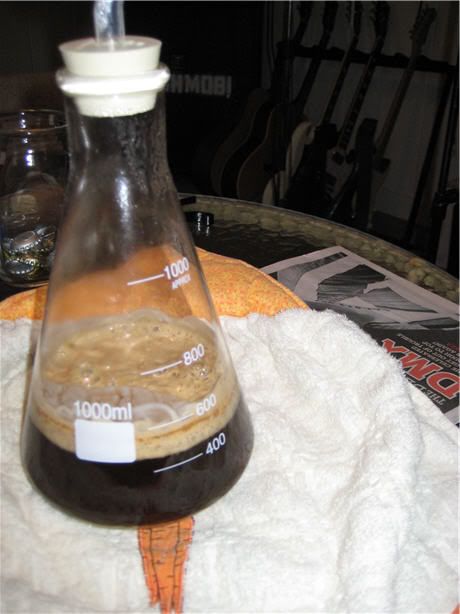Making a Yeast Starter
Making a yeast starter is essentially like making a mini-un-hopped batch of basic beer and inoculating it with the yeast you’ve purchased so they can begin to eat the sugars in the mini-batch of beer and reproduce. When you finally pitch this mini-batch of beer with all the additional yeast cells into the actual batch of beer you’re brewing, fermentation will begin much sooner and with much more vigor than it otherwise would if you’d just pitched the yeast you purchased directly into your batch of beer. There are many advantages to a vigorous and timely fermentation.
yeast you’ve purchased so they can begin to eat the sugars in the mini-batch of beer and reproduce. When you finally pitch this mini-batch of beer with all the additional yeast cells into the actual batch of beer you’re brewing, fermentation will begin much sooner and with much more vigor than it otherwise would if you’d just pitched the yeast you purchased directly into your batch of beer. There are many advantages to a vigorous and timely fermentation.
I’ve made yeast starters for my last two batches of beer, so I thought I’d photo-document the process the third time around. I’ll be brewing a Scottish 80/- Export Ale tomorrow (the 80/- means 80 shillings, which is how much a beer of this style and alcoholic strength was taxed when it was popular a few hundred years ago). I had a lot of success with the last yeast starter I did. Fermentation on that batch of coffee stout took off like a rocket, so I’d like to give every batch I brew that opportunity to succeed going forward. Nobody likes a sluggish fermentation.
Here’s how I’m making my yeast starters:
I made a stop at the brew shop on the way home from work Thursday night. There I selected and milled my grains, grabbed my hops and selected my yeast strain. In the world of homebrewing, much like in all competitive markets, there are a just a handful of major players that offer the most readily available product of the highest, comparable quality. In the case of yeast, these two companies are Wyeast and White Labs. I personally prefer White Labs over Wyeast. I had used Wyeast for the first handful of batches I did, but found the way their product is packaged (in a “smack pack”) wasn’t working for me. The last few times I used Wyeast I didn’t smack the pack right and the yeast nutrient inside the pack failed to release. White Labs yeast vials are much easier to deal with. Just open them up and pour out the yeast. Cool, dummy-proof. I’m sold. The White Labs strain recommended for Scottish Ales is Edenburgh Ale Yeast WLP028.
After properly sterilized everything Thursday night, I brought 4.5c of water mixed with 1c dark dried malt extract (dark DME) to a slow boil. I had purchased and used this same dark DME to make a yeast starter for the Off-leash Coffee Stout batch I brewed in December.
I let the boil run for a little over 15 min. to kill off any bacteria that may have slipped in the pot. I do this instead of boiling the wort directly in my beaker because I’m worried about the high potential for a boil-over that comes with boiling wort in a beaker. After the boil, I poured the wort from a height of about two feet over a funnel and into my yeast starter beaker in order to aerate the wort (yeast need some oxygen in the wort to ferment properly). I put a sterilized airlock on the beaker of wort and stuck it out on my back porch in the 15 degree Minnesota cold to chill from boiling down to room temperature. This took maybe 45 min. at the most.
boiling the wort directly in my beaker because I’m worried about the high potential for a boil-over that comes with boiling wort in a beaker. After the boil, I poured the wort from a height of about two feet over a funnel and into my yeast starter beaker in order to aerate the wort (yeast need some oxygen in the wort to ferment properly). I put a sterilized airlock on the beaker of wort and stuck it out on my back porch in the 15 degree Minnesota cold to chill from boiling down to room temperature. This took maybe 45 min. at the most.
Next I brought the beaker inside and pitched the yeast (which had been brought to room temperature slowly over the last few hours), re-sealed and set the beaker in a room of my house where liquid sits at about 60 degrees when it’s not fermenting (fermentation activity will heat up the liquid by a few degrees). This yeast was pitched at about 10:00pm Thursday 1/13.
I checked in on the starter 24 hours after pitching. A layer of active yeast (called krausen) had formed on the top of the fermenting wort, and a layer of dormant yeast cells had begun to collect at the bottom of the beaker (called trub). The airlock was bubbling vigorously at a rate of once every three seconds. At 1:00pm the next afternoon 1/15, the contents of the beaker didn’t appear much different but the airlock bubbling rate had slowed to once every five or six seconds. I had originally planned to brew on my day off – Martin Luther King Jr. Day 1/17 but since the fermentation in the starter is already starting to slow by Saturday and since I want to pitch as much active yeast as possible, I’ve now decided to move brew day up to tomorrow, Sunday 1/16.
the fermenting wort, and a layer of dormant yeast cells had begun to collect at the bottom of the beaker (called trub). The airlock was bubbling vigorously at a rate of once every three seconds. At 1:00pm the next afternoon 1/15, the contents of the beaker didn’t appear much different but the airlock bubbling rate had slowed to once every five or six seconds. I had originally planned to brew on my day off – Martin Luther King Jr. Day 1/17 but since the fermentation in the starter is already starting to slow by Saturday and since I want to pitch as much active yeast as possible, I’ve now decided to move brew day up to tomorrow, Sunday 1/16.
Lucky the wife and I didn’t have many daytime activities planned for Sunday. My Dad and I are heading to Williams Arena in Dinkytown at 4:00pm to watch some Minnesota Gopher basketball though, so I’ll have to make sure and start tomorrow’s Scottish Ale brew day relatively early.

Pingback: Making a Yeast Starter « Barking Dog Beer